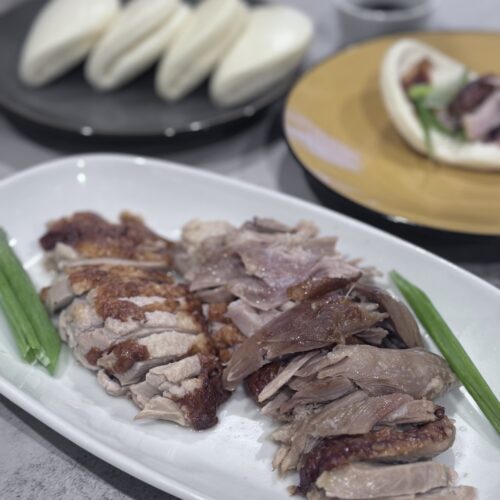
Easy Peking Duck
This easy and approachable recipe from Red House Spice requires minimal effort or special equipment.
Ingredients
- 1 duck about 5.5lb
- 2 tbs fine salt
For the Syrup
- 2 tbs maltose see note
- 1/2 cup hot water
- 1 tsp vinegar see note
For the Stuffing
- 2 stalks scallion
- 1 head garlic
- 2 apples, quartered
- 4 star anise, whole
- 4 bay leaves
- 2 pieces cassia cinnamon
For the Sauce
- 3 tbs sweet bean sauce (Tian Mian Jiang) see note
- 1 tsp sugar
Instructions
- Pat dry the duck with kitchen paper then rub the salt over the skin and the cavity. Put the duck over a wire rack with a tray underneath to collect any drips. Leave to rest on the counter for 1 hour.
- Bring about 1½ litres of water (about 6 cups) to a boil, then gently pour it over the entire duck skin (remember to flip over and do the other side). You can use a deep tray to collect the water, or do it inside a sink. If there are feather ends on the skin, remove them with a tweezer.
- In a bowl, mix maltose with hot water and vinegar until completely dissolved. Brush a layer of the mixture over the duck skin. Leave to rest in the fridge for 1 hour then brush another layer.
- Keep the duck refrigerated uncovered (over the rack and inside a tray) for 24 to 48 hours.
- One hour before roasting, take the duck out of the fridge to bring it back to room temperature. Put all the stuffing ingredients (scallions, garlic, apples, star anise, cassia cinnamon and bay leaves) into the cavity. Use toothpicks or skewers to seal the openings of the cavity.
- Preheat a fan-assisted oven, aka convection oven, at 200°C/390°F (or 220°C/425°F if using a conventional oven). Put the duck over the middle rack of the oven with the breast side facing up. Place a roasting tray at the bottom of the oven to collect any dripping fat during roasting. Leave to cook for 15 minutes.
- Then lower the temperature to 180°C/350°F (or 200°C/390°F if using a conventional oven). Use aluminium foil to cover the tip of the wings and the end of the legs. Continue cooking for a further 60 minutes or so (see note 4)
- Check the doneness by inserting an instant-read thermometer into the thickest part of the duck (the inner thigh area near the breast). The temperature should be no lower than 74C°/165F°.
- Take the duck out of the oven and leave it to rest on the counter for 15 minutes.
- While waiting, prepare the sauce. Add ½ tablespoon of duck fat collected during roasting to a pan. Add sweet bean sauce and sugar. Mix and simmer over low heat until tiny bubbles appear. Transfer to a small serving dish. Whisk to fully incorporate the sauce and oil.
- Steam the bao buns for 3 minutes to warm up if they’re cold. Slice the duck into pieces.
- When eating, spread a little sauce over a bao bun, put the duck, scallions and cucumber in the middle. Wrap up into a cylinder and enjoy.
Notes
1. It’s best to use maltose (Mai Ya Tang, 麦芽糖) but if unavailable you may replace it with honey. In this case, mix 2 parts of honey with 1 part of hot water. 2. You can use any type of vinegar available. Or use fresh lemon juice to substitute. 3. Sweet bean sauce (aka sweet flour sauce, sweet wheat sauce) is the classic choice. Possible substitutes include hoisin sauce, yellow soybean sauce, or plum sauce. 4. The roasting time may vary depending on the size of your duck and the performance of your oven. Please observe and check often. Adjust if necessary.